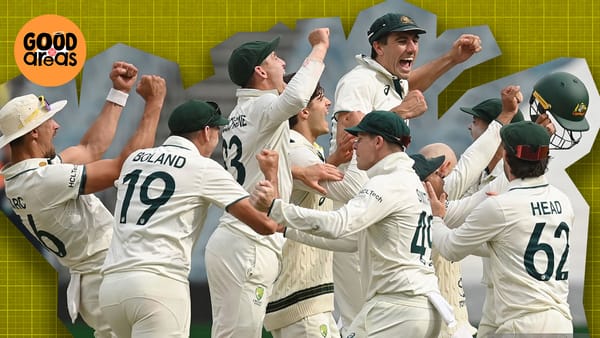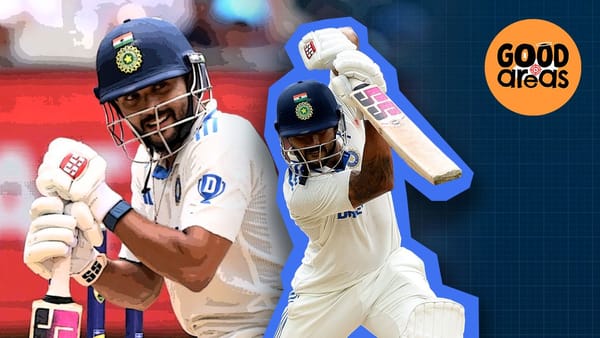Pakistan bringing draws back
Draws have disappeared from Test matches, then we started playing in Pakistan again.
There is a celebration about cricket coming back to Pakistan. We’re now seven Tests in, and you can see the way the Australians have been treated.
Wow! @melindafarrell on the front page of the express tribune here in Islamabad. On top of the fold above the great @ImranKhanPTI 🇵🇰🏏🇦🇺
— Todd Greenberg (@Todd_Greenberg) 9:11 AM ∙ Mar 7, 2022
Perhaps the best way to show this is Melinda Farrell on the front page of the Tribune. It is not normal to have a cricket journalist on the front page of a newspaper. We are not that famous—even Mel.
Daal and roti for lunch too. Delicious
— Marnus Labuschagne (@marnus3cricket) 9:35 AM ∙ Mar 11, 2022
I mean even Marnus Labuschagne’s grub went viral. That’s the kind of series this has been. Almost no one expected the Australians to turn up, especially after the New Zealand and England stuff.
And so it’s even more of a celebration than just the fact that with Pakistan playing cricket at home makes our game feel more complete.
And people are talking up the first Test, which was one of the most tedious matches we’ve had in a long time. But even then people still liked it, because its major Test cricket in Pakistan.
The same thing happened here. Obviously, this was a better draw. Australia batted for two days with Usman Khawaja enjoying his new go at it. Then Pakistan were bowled out for 148, although bowled out is the wrong way to look at it, two of them were run outs.
Then Australia gave their bowlers a session off. Babar Azam helped Pakistan to save it as Nathan Lyon made it exciting enough that we got that fifth-day buzz. But there is a critical stat here: the fifth most overs ever in the fourth innings. It’s important to note what an outlier this result is; batting this long to draw doesn’t happen often.
Some think Australia were wrong not to enforce the follow on, but only one time in the history of our game has a team batted more overs in the fourth innings of a match and managed to draw. This was a fluke result, inspired by a great Pakistan performance and a friendly pitch.
This was an incredible event, but if it was going to happen anywhere, Pakistan makes sense.
Because cricket has completely changed since Pakistan last played at home. From 2000 until the beginning of 2010, draws were common.

It was a great batting period for our game. And we had a lot of dead Tests. Not that all draws are like that, but it was undoubtedly a less entertaining era of cricket than we have now. It feels weird to look back and remember that a quarter of matches as draws.
The West Indies had almost 40% of the Tests there drawn in that period. They had some tedious surfaces where Shivnarine Chanderpaul would dig himself in for a day and half. India were not far behind either, with just pristine batting pitches that often didn't break up as hoped.

Both New Zealand and Pakistan were over 30% as well. These four nations were draw happy at this point.
In 1980 over 50% of Tests were drawn; since 2000, we’ve only had three years over 30% of draws.

So by the change of the century, it was clear that draws were on their way out. So these locations were the holdouts. They were keeping the draws alive. But the game clearly changed in the 90s, and the idea was to get a result where possible.
The generation after Pakistan stopped playing at home, there was a nine-year period where draws started dropping.

Heading down from a nearly a quarter to a fifth.
But by decade doesn’t give it its true justice, because it’s since 2015 where the whole thing has gone crazy. But let’s take a look, the 50s were pretty dire Tests, and then the 60s started warming up a bit. You can see the variance here from year to year because of how few Tests we had played.

But by the 80s we have more matches, and you can see how high the draw levels are. But late 90s it drops, and then in the 2000s it continues to be low, and then after 2010 it drops again. And drops, and drops, and then by the peak of the pace playing pandemic, only 10% of Tests are drawn. It’s had a slight bounce back. But, this is low. Historically low.
And that is the period that Pakistan has re-entered. They have had three of them being drawn.

England has had five, but in 19 Tests. Pakistan has only played seven Tests back at home.
So let’s look at the percentages. And this is when you see that Pakistan has managed to have a massive amount of draws in what is a fairly small sample size at this stage.

Just seeing three draws in seven matches feels like it has come from another era. It was how cricket was once played, before we followed it via Twitter and streaming platforms.
It’s like in going back to Pakistan Tests are stuck in a time-warp and the pitches have not at all developed. They just paused the game and we still have cricket on genuine 2009 pitches. Like the curators completely skipped the pace pandemic and are just rolling the hell out of it without watching any modern cricket.
For the next Test they are calling in the ICC curator. Just trying to find anyone who has seen a Test in the last decade.
Pakistan has brought the draw back, and usually that would be enough to upset everyone. But because cricket is so happy to have them at home, they're getting a better run of it. Despite the fact they are producing epicly turgid surfaces.
Pakistan Test cricket is back. Back in 2009.
On Pakistan, I linked to it above, but if you are a fan, this week I sat down with Wasim Khan on his time with the PCB. It’s a really open conversation about his career, and then time with the PCB that ended early.




